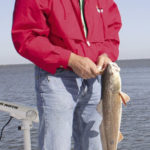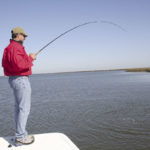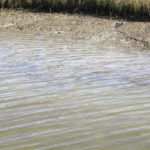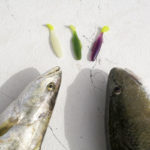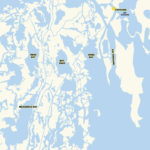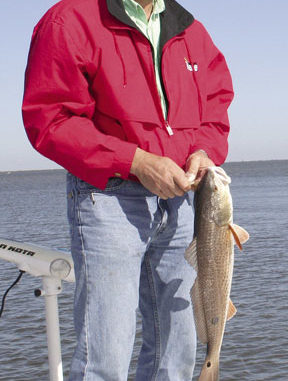
December’s the perfect time to make a short milk run to easy speck and redfish action in Terrebonne Parish.
The Dulac/Cocodrie area presents a wide range of options for warm-weather speck chasers. From the Lake Barre oil and gas fields to the east to the feast-or-famine run to Raccoon Island and the small cluster of rigs to the west, anglers and area guides have lots to choose from in the sweltering summer months.
Come late fall and wintertime, however, Capt. Andre Boudreaux of Pointe Cocodrie Inn needs only a small stretch of waterways along a well-known gateway to the Gulf to fill his box when a case of sports drinks chilling in the ice chest isn’t required equipment.
“The stretch from, starting from the south, Mangrove Bay to Deer Bay and up to Bay Antoine is a really good little milk run, especially for guys not too terribly familiar with the area,” said Boudreaux last December in the dining area of his place.
Thick fog hid the opposite shoreline outside the south side of the building as workers milled about, waiting for the OK to get back to work fixing what Hurricane Gustav had wrought.
“If you can’t see that shoreline, you’ve no chance to safely navigate the ship channel,” said Boudreaux, referring to the Houma Navigational Canal, a short hop from the Pointe Cocodrie and entrance into the trio of bays adjacent to Bayou Sale (pronounced Sally) that continually give up bulging ice chests full of speckled trout as well as strong numbers of redfish along their shell-studded shorelines.
“Mangrove Bay is generally better earlier in the fall, a lot of times when fishermen think the fish haven’t moved in yet,” said Boudreaux. “It’s just the natural progression of the fish moving up along marsh as it gets cooler.
“Deer Bay and Bay Antoine are basically the same kind of habitat, but they’re farther inland. The fish will generally stick around there through the cold-weather months. Both have a pretty good flow of water moving through, which helps keep it clean except on the worst of cold fronts. But those are the days when there’s no clean water anywhere.”
Indeed, the rapid loss of land in the area due to coastal erosion has served anglers another surprise in this era of coastal fishing as theorized by many. Coastal passes, cuts and bayous are wider and cut deeper by natural current. In turn, when cold fronts blow through, the water leaves quickly and moreso than in years past.
“I don’t know about that theory, but it does make some sense,” Boudreaux said. “And it really does seem like you get a lot of people saying ‘I’ve never seen the water this low’ when a strong front comes through.”
Around 9 a.m., the oyster grass on the opposite bank came into view, the signal to at least give the trip a go. A quick hop through the spooky Ship Channel and Deep Saline — a body of water belying its name — ended up in Deer Bay, where the fog was thinning but so was the tide, which had been pulling out since we had arrived early in the morning.
“The best tide around here for trout is an outgoing right at high water. This fog’s not doing us any favors today,” said Boudreaux as we struggled to put picture-worthy specks in the boat using his array of H&H soft plastics, both under a cork and tightlined.
Drifting a hundred yards or so off the shoreline is a surefire bet for productive trout snatching, and these bays are no exception. This morning’s lack of wind largely prevented such tactics.
“It’s a good way to cover a lot of water,” Boudreaux said. “The fish are, for whatever reason, going to be holding on a particular stretch of this bay for the most part. It’s not always something you can see like a school of bait. It might be bait that’s holding under the water. Just keep prospecting, and you’ll come across them.”
Soon, our focus turned to redfish along Deer Bay’s now-exposed shoreline. Boudreaux explained that despite the beautiful oyster shell-cleansed water and the attractive incongruities, anglers should be patient in this part of the marsh.
And be ready.
“The reds around here travel in packs more often than in most places,” he said. “These shorelines are really pretty redfish water when the tide gets lower, and it seems like you should be coming across fish every hundred feet, but usually it doesn’t happen that way. Groups of three to even 10 fish are pretty common here. You’ve got to just cover some ground.”
Boudreaux proved prophetic as we eased along hundreds of yards of spectacularly clean water, where it seemed a sin that a redfish wasn’t seen cruising through to its next meal. A small island’s backside flat first showcased a single red pectoral fin drinking in the sun that had finally come out. In the next half minute, five more bronze warriors were made, followed by two more as our lures simultaneously entered the water. Both Cocahoe tails were eaten instantly, and the remaining fish high-tailed it toward the security of the middle of the bay.
“I guess this is the best part of this area,” Boudreaux said. “When the water drops out in all three of these bays — and that’s generally later in the morning — the redfish will get on these shell banks and sun themselves. The trout shut down later in the morning, but that’s usually just in time for the reds.”
Kent Lavalier is a retired roofing contractor, spending a large block of the fall and winter fishing season at his camp on Four Point Road, a rustic relic that has admittedly seen better days but has also seen its way through its share of tropical skirmishes just fine. It’s also seen plenty of spots and dots hauled over its owner’s gunnels to the adjacent fish-cleaning table, many of both coming from the area described above.
“That’s a great little milk run beginning in around the middle to late part of October,” said Lavalier. “The best part of fishing that time of year is that generally you can use the wind to your advantage. And it’s almost always a little breezy that time of year.”
Drifting is an important part of Lavalier’s gameplan in almost all of his fishing applications. Having spent a good bit of time along the middle coast of Texas, he learned quickly the intricacies of drift fishing. It was either that or get in the water with everyone else.
“That’s not something I was interested in,” he said. “Those guys just can’t wait to jump out of a perfectly good boat. I was partners with a guy in a boat that could handle the big-water crossings you have to do over there, but it didn’t have a trolling motor,” said Lavalier. “So, I asked around, got a hold of some windsocks and started drifting.”
Windsocks are basically parachutes for water. They’re deployed over the windward side in order to slow one’s drift and, with some deft tying off, can angle ones boat so that multiple people can fish.
“You don’t see them a whole lot in Louisiana because, for the most part, if the wind’s blowing that bad, the water’s going to be bad. At least that’s the general thought process,” said Lavalier. “The bottom is much sandier over there in Texas, especially the farther south you go, so the water stays clearer. And if you don’t like wind or can’t get used to it, you don’t even bother going fishing in Texas.”
Lavalier puts them to use in positioning his 21-foot Fishmaster so that he can drift broadside — or at least he used to before they were misplaced prior to Hurricane Ike. After checking prices in several catalogs, he decided to try a pair of five-gallon buckets, which did the trick nicely.
“They take up a little room and they’re a little noisy when you pair them up, but a little coat of spray foam has worked so far. You just don’t want them clanging together out there when it really gets rough.” said Lavalier.
Breezy days requiring a pair of buckets are actually times Lavalier likes the most. While most fishermen think fall and winter are times when bigger fish disappear, Lavalier theorizes that it’s mostly about the intense pressure often seen on cool weekends when speckled trout are available to boats of almost any size.
“The bigger fish — fish over 20 inches or so — have got a few years on them,” he said. “They’ve been through a few seasons out at the islands where you can pretty much walk from end to end on a Saturday morning. They know noise and when to stay away from it, especially when you’re talking about relatively small water.
“The breezy days when there’s nobody else out there banging around their anchor is when you can get some bigger fish. I’m not talking about 5-pounders or anything — there’s just not many of them around here — but there is a crop of 20- to 23-inch fish that can be had if you do the right things.”
Cleating wind socks off on both bow and stern allows this and allows him to fish comfortably from the front deck, as well as giving needed space and equal water to guests in the back. Lavalier is also a stickler for almost never anchoring his boat, even when he and a partner hook up at the same time.
“The minute you stick an anchor or a mud stick or whatever, you change your surroundings dramatically,” he said. “You go from being a part of nature, just drifting along with the waves, to being a foreign object that’s making noise each time the tiniest wave hits the side of your boat. Now, I’ve been proven wrong more than a few times when the fish are just stupid in numbers and they’re on a good feed, but for the most part, that’s a no-no in my book.”
Though his methods are unorthodox, Lavalier uses the time-honored cork-and-plastic rig for the majority of his fish, especially when the wind blows.
“You’ve got to let the fish know you’re there when the water is stained or even when it’s clean but there’s a chop,” he said. “You do that with a thicker bait that moves some water, a bait with a heavy tail vibration or with a snap cork. Sometimes I use all three, but I almost always use two.”
For the bigger fish, he’ll use a trick he saw in an old issue of Tide magazine from a Florida fisherman. It required a wired and beaded cork, a 2-foot leader, a 1/8-ounce jighead and a 5- or 6-inch soft-plastic Fluke-type bait.
“It takes a little patience, but you throw that out and instead of popping it, you slowly reel it in for a few seconds and then stop for a second and give it a little pop,” he said. “That long jerkbait tail will jump up and slowly fall. When they hit it, for some reason, you’ve really got to give it a second or two before setting the hook. But that’s a good way to catch some of the bigger fish out there.”
